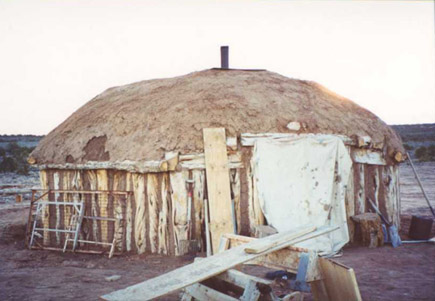This is exactly what happened to me, and after I realized it I was incredibly grateful that I still had a chance to reverse my course and offer my children something different. So my family and I moved back to the Navajo reservation and were given an opportunity to live in a one room hogan out on a sheep camp located on a dirt road six miles off of the nearest paved road. For three years we lived there with no running water or electricity. We had a dirt floor and an outhouse about 50 yards away. Sheep, cows and horses frequently grazed right outside our door, and we lived alongside and at the mercy of the elements (wind, cold, heat, rain, snow and mud).
Since graduating from college I have been trained and began working as a computer programmer and data analyst doing technical support, database design and web programming. And while living in Denver I started doing contract work for companies remotely, outside of the Denver area. Most of the time, I would telecommute over the internet and occasionally would travel to visit my clients on site. Prior to our move back to the Navajo Nation, I tested and discovered that I could receive a digital cellular signal at our hogan. This meant I would be able to keep working for my clients; by connecting my cell phone to my laptop I could use it as a modem and get on the internet at DSL speeds (I call myself the Verizon Wireless poster child). Once I was on the internet, I could perform all of my assigned duties for the clients I was working for, or at least in 3-4 hour segments, which was the battery life of my laptop and cell phone. But I was also able to charge them in our car if a longer work session was necessary. I found this arrangement worked out extremely well and was delighted that I could give my children the experience of growing up in a very traditional Navajo setting while still demonstrating to them that we could also actively participate in the Global Marketplace.
No, I'm happy to admire Indians from afar while I live like a typical American. About the only way I'm like a traditional Indian is that I live frugally and try not to waste anything.
For more on the subject, see No Authentic Indians Left? and Navajo Innovation Meets Tradition.


I'm not sure what part of Dinetah the writer lives on but where I live the children still run with their elders in the morning, people still pray with the taa'di'diin in the morning and evenings, and people still help each other and try to serve the people. If Dine' bizaad is spoken less often it is still spoken at home. It is good you have learned to return to live back on home. Many homes have solar and wind energy these days and get their water from wells like we do. It only takes a digital umbilical cord to work these days while enjoying the old ways. Hozhonji nahaastliin.
ReplyDelete